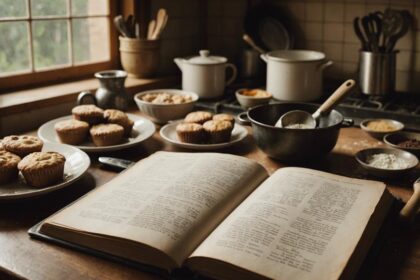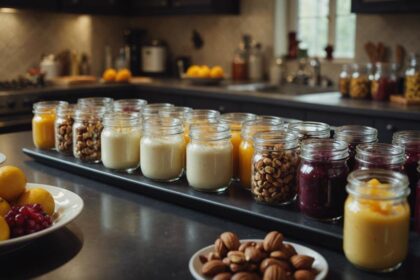You're about to master Sachertorte, the classic Viennese chocolate cake. Start with high-quality ingredients, including cake flour, semi-sweet chocolate, and apricot preserves. Accurate flour measurement and gentle mixing are key to achieving the perfect texture. Bake it in a 9×3 round pan and let it cool completely before glazing. For best results, allow the cake to rest overnight to enhance its flavor. When serving, a dusting of powdered sugar or a drizzle of chocolate glaze elevates presentation. Ready to impress? Keep exploring to uncover tips and variations that'll make your Sachertorte unforgettable.
Recipe Ingredients and Nutritional Information
To bake a delicious Sacher Torte, you'll need 10 essential ingredients that create its signature flavor. Start with cake flour and baking powder to build the cake's structure. For that rich chocolate taste, use semi-sweet chocolate along with unsalted butter to enhance the texture. Granulated sugar sweetens your creation, while eggs provide moisture and richness. The inclusion of high-quality butter is vital for achieving the cake's signature taste.
Don't forget the apricot preserves, which add a unique fruity note that complements the chocolate beautifully. For the glaze, incorporate ingredients like dark rum and corn syrup, adding a glossy finish to your cake.
The nutritional profile of this indulgent treat is significant; each slice contains about 470 calories, comprising 52g of carbohydrates, 6g of protein, and 29g of fat. When you slice into this cake, you'll appreciate the balance of flavors and textures, thanks to your careful selection of ingredients.
Store your Sacher Torte at room temperature for several days, covered to maintain freshness, or freeze individual slices for later enjoyment. This recipe not only satisfies your sweet tooth but also provides a delightful experience in every bite.
Baking Techniques and Instructions
To achieve the perfect Sachertorte, you'll need some essential baking equipment and the right mixing techniques.
Start by measuring your flour accurately to get that ideal texture, and use a 9×3 round cake pan for the best results.
Understanding how to fold in the chocolate and egg whites properly will elevate your baking game and guarantee a light, airy cake.
Additionally, mastering the use of choux pastry techniques can inspire your approach to creating a beautifully layered cake.
Essential Baking Equipment
Having the right baking equipment is essential for achieving the perfect Sachertorte. Start with a 9×3 round cake pan for the best results, though alternatives like an 8×3 springform or 9×2 round pans will work well too.
Make sure to measure your flour accurately using the dip & sweep method; this helps you sift together the right amount for a well-textured cake batter.
Before you pour in the batter, always check the oven temperature with an accurate thermometer. This prevents undercooked centers and lets you adjust your baking time as needed.
Once the cake is baked, let it cool completely in the pan to avoid melting your chocolate glaze when it's time to decorate.
When you're ready to incorporate the egg whites, remember to fold whipped egg whites into the batter in three batches. This technique maintains aeration and gives your Sachertorte that light, fluffy texture everyone loves.
With the right equipment and techniques, you'll master this classic Viennese dessert in no time!
Mixing Techniques Explained
Once you've gathered your baking tools, it's time to focus on the mixing techniques that will elevate your Sachertorte. Start by measuring your flour using the dip & sweep method to guarantee accuracy. This prevents overmixing, which can ruin the cake's tender texture.
When it comes to combining ingredients, melt your chocolate and fold it into the batter gently. This maintains aeration, keeping the cake light and fluffy.
Next, incorporate your whipped egg whites in three batches. Use a rubber spatula to fold them in carefully, avoiding deflation of the mixture. Remember, the goal is to keep that airy consistency intact.
After adding the flour, mix until just combined; overmixing at this stage will lead to a tough cake.
Common Baking Issues and Solutions
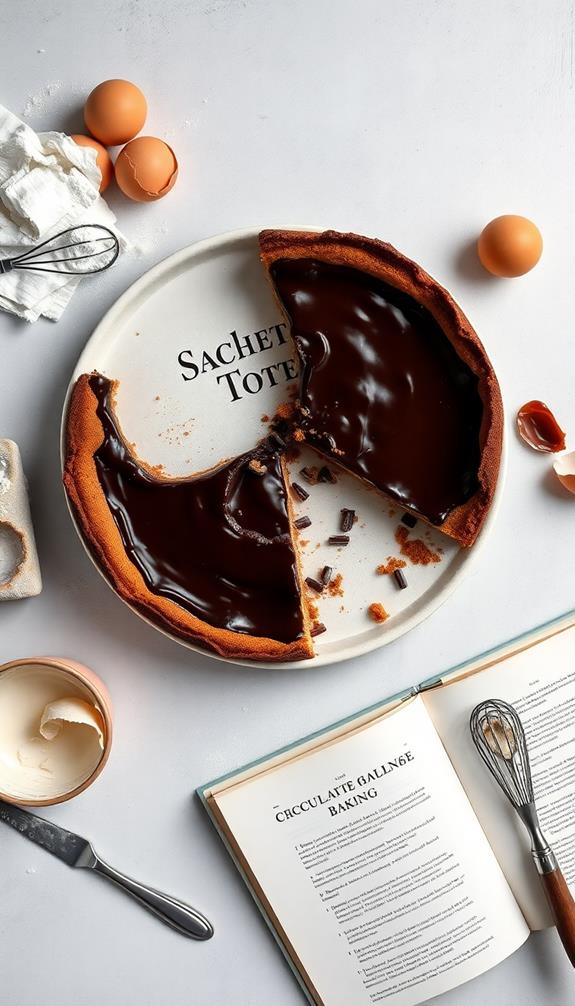
Baking can sometimes feel like a science experiment, where small missteps lead to unexpected results. To help you navigate common issues with your Sachertorte, here are some tips to guarantee your cake turns out perfectly:
- Egg Whites: If you overmix the egg whites, your cake may deflate. Always fold them gently into the batter in three batches for ideal aeration. Incorporating a light touch is essential, much like the delicate layers in an Elegant Layers Gateau Opera to achieve the desired texture.
- Oven Temperature: An inaccurate oven temperature can cause undercooked centers or uneven baking. Use an oven thermometer to guarantee it's just right.
- Glaze Consistency: If your glaze is too thin or grainy, you might need to adjust the cooling time or re-melt it gently to achieve the desired consistency.
Don't worry if your Sacher Torte develops a crackled appearance as it cools; this is normal.
Handle the batter gently to minimize puffing. To prevent dryness, spread apricot preserves generously between the layers and let the cake rest overnight. This will enhance moisture and flavor, guaranteeing your Sachertorte is a delicious success!
Ingredient Substitutions and Density
When you're preparing a Sachertorte, ingredient substitutions can greatly impact the final result. For instance, if you want to switch out dark rum, brandy works nicely or you can skip it for a non-alcoholic version without compromising the cake's flavor profile.
Additionally, using gluten-free flour instead of traditional flour can also create a unique twist on this classic cake. When it comes to the chocolate glaze, you can substitute corn syrup with agave nectar, keeping in mind that this may slightly alter the glaze's texture.
Understanding ingredient density is essential in baking. Butter is denser than flour, so accurate measurement is key to achieving the right batter consistency.
If you decide to use a different jam instead of traditional apricot jam, consider the density and sweetness of your substitute. This guarantees it complements the bittersweet chocolate without overpowering the dish.
To simplify your preparation process, line your cake pan with parchment paper. This eliminates the need to butter or flour the sides, making it easier to release the cake later.
Storage and Serving Suggestions
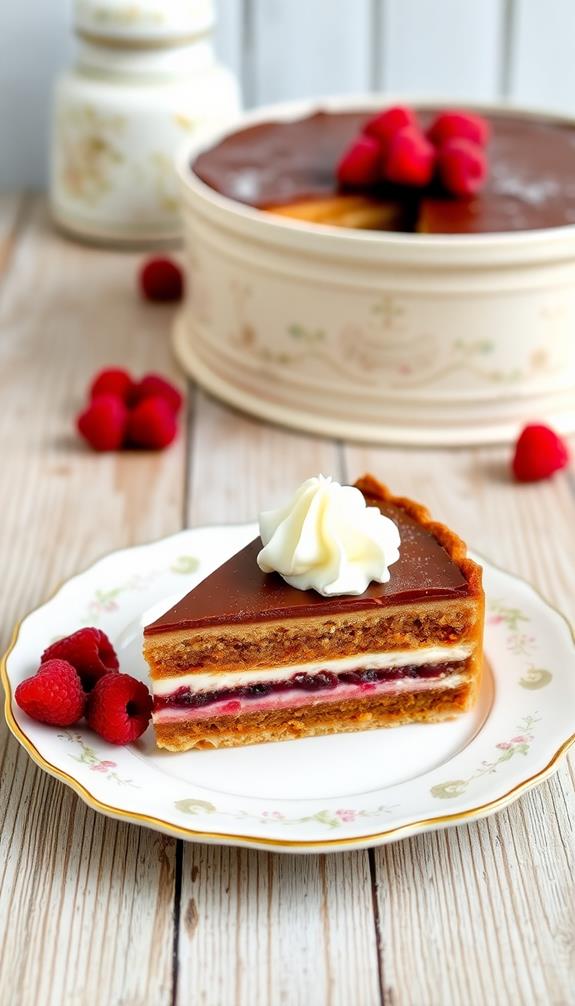
To keep your Sachertorte fresh, store it covered at room temperature for up to three days, or individually wrap slices and freeze them for later enjoyment.
For the best flavor, let the cake sit overnight after baking and consider letting it rest for 1-2 days before serving.
A festive bread like Traditional Julekage can also complement your dessert table during celebrations.
Enhance your presentation by dusting it with powdered sugar or drizzling chocolate glaze, making it even more delicious.
Ideal Storage Conditions
Although the Sacher Torte is best enjoyed fresh, you can store it effectively to maintain its deliciousness. When you want to keep your cake for later, remember these tips:
- Room Temperature Storage: You can store the Sacher Torte at room temperature for up to three days if it's covered properly. This helps prevent it from drying out and losing its rich flavors.
- Individual Slices: If you have leftover slices, wrap them in plastic wrap and freeze them for long-term storage. This method preserves the cake's flavor and moisture beautifully.
- Let It Sit: Allow the cake to sit overnight before serving. This resting period enhances the moisture and flavor profile, giving you the best taste when you finally indulge.
To maintain texture, use a cake dome or loosely cover the cake to prevent exposure to air.
Following these ideal storage conditions guarantees that your Sacher Torte remains a delightful treat, ready to impress anyone who's fortunate enough to enjoy a slice!
Best Serving Practices
Serving your Sacher Torte at its best can elevate the entire dessert experience. For ideal flavor, let the cake sit for 1-2 days before serving, allowing the apricot jam to seep into the layers.
Store your torte at room temperature under a cake dome or loosely covered with plastic wrap to maintain freshness for up to three days. This guarantees that each slice stays moist and delicious.
When you're ready to serve, consider the best serving practices to make it truly special. Dust the top with powdered sugar or drizzle it with additional chocolate glaze for an elegant presentation.
Pair the Sacher Torte with a side of whipped cream or fresh berries to enhance its rich chocolate and apricot flavors.
If you have leftovers, individual slices can be wrapped in plastic wrap for long-term storage in the freezer, preserving quality for future indulgence.
Just remember to let them thaw at room temperature before enjoying. With these serving suggestions, your Sacher Torte won't only taste fantastic but also look stunning on your dessert table.
Enhancing Flavor Pairings
When you want to enhance the flavor of your Sacher Torte, consider pairing it with complementary elements that elevate both taste and presentation. Allowing the cake to sit for 1-2 days before serving boosts its moisture and deepens the chocolate and apricot jam flavors.
To take it up a notch, here are three delightful serving suggestions:
- Whipped Cream: The light, airy texture provides a lovely contrast to the rich chocolate, balancing the flavors beautifully.
- Vanilla Ice Cream: A scoop of creamy vanilla adds a delightful chill that enhances the Sacher Torte's warmth and richness.
- Raspberry Jam: For a twist, this fruity alternative to apricot jam can add an exciting dimension to each bite.
Don't forget to finish your presentation with a light dusting of powdered sugar or a drizzle of chocolate glaze to make it visually stunning.
When storing the cake, keep it under a cake dome or loosely covered at room temperature to maintain its flavor and texture for several days.
Enjoy your Sacher Torte with these enhancements for a truly memorable experience!
Origin and Cultural Significance
The Sachertorte, a symbol of Austrian culinary artistry, was born in 1832 when 16-year-old Franz Sacher crafted it for the elite guests of Prince Klemens Wenzel von Metternich. This rich chocolate cake, layered with apricot jam, has become a national dessert that represents Austria's culinary heritage. Its creation marked a pivotal moment in the history of desserts, much like the cultural significance of apple pie in America.
The Sachertorte's roots echo the way the classic recipe of tiramisu evolved in Italy, showcasing how regional specialties can grow into beloved global delicacies. The original recipe remains a closely guarded secret, adding to the allure of the Sachertorte and inspiring numerous variations in cookbooks worldwide.
This dessert's simplicity and elegance reflect principles similar to Bauhaus design, marrying minimalism with flavor. You'll find the Sachertorte traditionally served during special occasions and holidays, embodying a deep-rooted culinary tradition that Austrians cherish.
As you explore this classic treat, you'll appreciate not just its taste but also its rich history and cultural significance. Whether it's a festive celebration or a simple gathering, the Sachertorte continues to delight palates and evoke a sense of pride in Austrian culinary artistry.
Enjoy mastering this iconic dessert and becoming part of its storied legacy.
Glazing Techniques and Tips
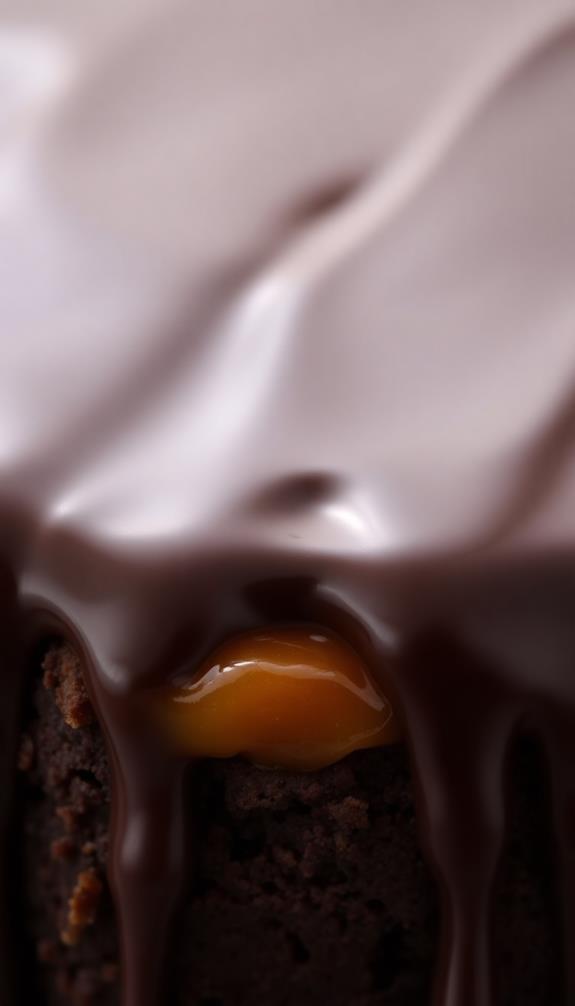
To achieve a stunning finish on your Sachertorte, mastering the glazing technique is vital. A well-executed glaze not only enhances the cake's appearance but also elevates its flavor.
Just as with the intricate layering of an Opera Cake, attention to detail is key in creating a visually appealing dessert. Follow these steps to guarantee a perfect glossy finish:
- Prepare your glaze: Boil a mixture of sugar and water until it reaches a syrupy consistency, then incorporate coarsely chopped chocolate and butter for that rich flavor.
- Monitor the temperature: It's essential to prevent graininess in your glaze. Make sure all ingredients are well combined and keep an eye on the heat to avoid overheating, which can cause separation.
- Pour the warm glaze: Once your glaze is ready, pour the warm glaze on the top of the cooled cake, allowing it to drip down the sides for an even coating. Aim for a thickness of about 4 mm; if it's too thin, add more syrup to achieve the desired consistency.
After glazing, let the glaze set at room temperature for several hours. This will give your Sachertorte a firm texture and a beautiful, shiny finish that's sure to impress!
Conclusion
Now that you've mastered the sachertorte recipe, don't let any concerns hold you back. You might think it's too complicated, but with practice, you'll find it's just about following the steps and adding your personal touch. Picture a rich, glossy chocolate glaze enveloping a moist, dense cake, topped with a dollop of fresh whipped cream. It's not just a dessert; it's an experience. So, roll up your sleeves and impress your friends with this classic Viennese treat!



